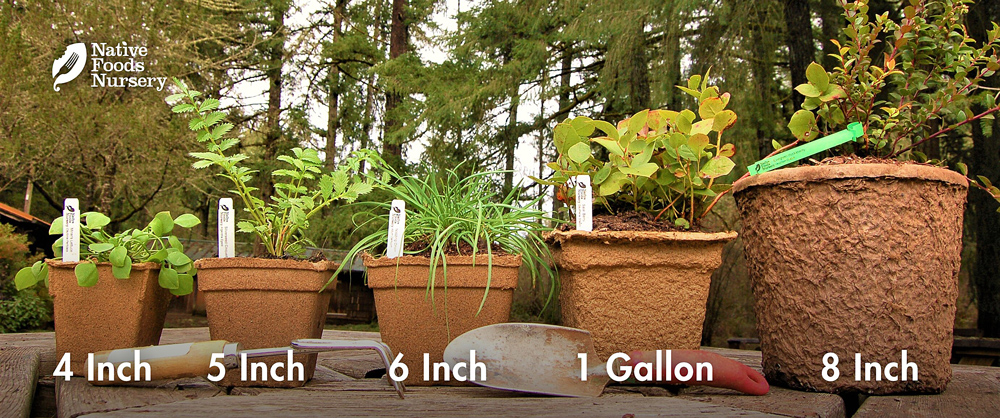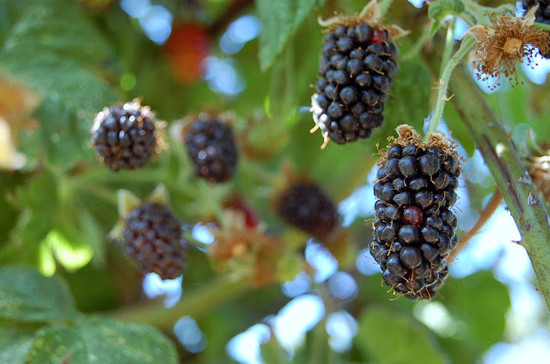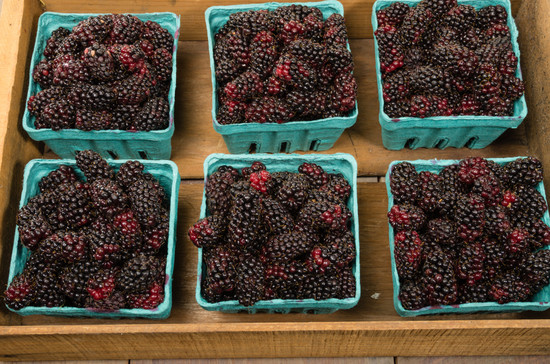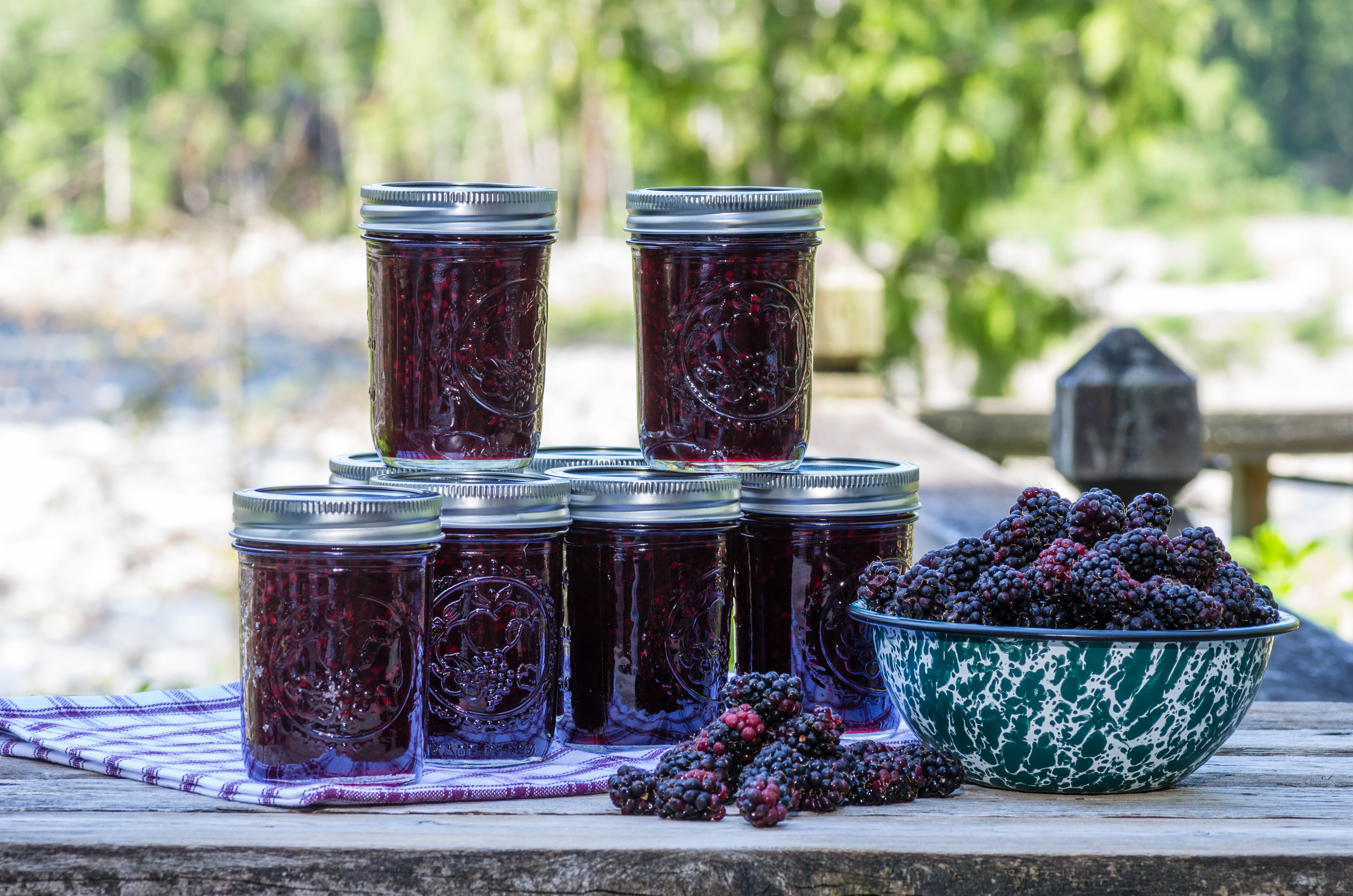Marionberry
- Current Stock:
- 0
- Other Names:
- Marion Blackberry, Blackberry Marion, Oregon Blackberry, Queen of Blackberries
- Latin Name:
- Rubus ursinus X idaeus. 'Marion'
Marionberry is Oregon’s signature trailing blackberry—bred for its lush, winey aroma, vibrant sweet-tart balance, and that “wild” depth inherited from native lineage. Released in 1956 from a cross of ‘Chehalem’ × ‘Olallie’, it quickly became the processing gold standard in the Willamette Valley and a favorite for home gardens seeking peak blackberry flavor [1][2][3].
Note: ‘Marion’ is a thorny, trailing blackberry that fruits on second-year canes (floricanes) and performs best on a trellis in full sun [4][5].
Edible Uses
Among the finest blackberries for pies, jams, syrups, smoothies, and fresh eating, Marionberry combines aromatic complexity with relatively small seeds and excellent processing character. Blackberry fruit is naturally rich in anthocyanins and phenolics with notable antioxidant capacity; ‘Marion’ is widely cited for superior flavor and aroma in puree/IQF products [2][6][7].
Ornamental Qualities
White spring blossoms and long, arching canes make a handsome, fruiting espalier or two-wire row. On a simple trellis, ‘Marion’ brings clean structure, showy bloom, and a heavy mid-summer crop—pair nearby with Evergreen Huckleberry, Red Flowering Currant, or Serviceberry for multi-season interest and cross-promotion [4].
Environment and Culture
‘Marion’ was bred in Oregon and is tailored to the PNW’s maritime climate. Its pedigree includes substantial native trailing blackberry (Rubus ursinus) ancestry (approx. 44% R. ursinus), which underpins its “wild” flavor profile [1]. Indigenous communities continue to eat and tend R. ursinus as living food and land tradition; honoring that stewardship acknowledges the knowledge behind the flavors we prize today [8] (Learn more & how to help on our Charitable Giving page.)
Harvest, Care, and Preparation
Site & soil: Full sun; well-drained, organic-rich soil. Trailing types are the least cold-hardy blackberries; protect in colder pockets and avoid waterlogging [4].
Training & pruning: Summer-bearing; fruit on floricanes. Train new primocanes along wires in year one; after harvest, remove spent floricanes and tie in the next cycle [4][5].
Water & nutrition: Keep even moisture during bloom/fruit fill; top-dress with compost in spring (avoid heavy N) [4].
Pollination: Self-fruitful; bee activity improves set and uniformity [5].
Harvest window (PNW): Typically mid-July in the Willamette Valley; a ~4-week season depending on weather and site [4].
(See Planting Guide in next tab for more info.)
Attributes
Type: Trailing blackberry cultivar (‘Chehalem’ × ‘Olallie’)
Native Ancestry: ~44% Rubus ursinus in pedigree [1]
USDA Zones: ~7–9 (trailing types are least cold-hardy) [4]
Ease of Care: Moderate (requires trellis; vigorous canes) [4]
Thorns: Thorny (use gloves for training/harvest) [2]
Light Requirements: Full sun (6–8+ hrs)
Soil Type: Well-drained loam/sandy loam; avoid waterlogging [4]
Water Requirements: Even moisture during bloom/fruit fill; reduce after harvest [4]
Pollination: Self-fruitful (bee activity boosts yield) [5]
Bearing Age: Year 2 on floricanes (after establishment) [5]
Cane Length: Often 16–20 ft; train on a two-wire trellis [4]
Plant Spacing: ~3–5 ft in row; ~8–10 ft between rows (home scale) [4]
Bloom Time: Spring
Harvest Time: Mid-July (PNW lowlands), ~4-week season [4]
Primary Uses: Fresh, freezing, pies, jams/syrups; premium processing quality [2]
Companions: Evergreen Huckleberry, Red Flowering Currant, Serviceberry (similar water/soil aesthetics)
References
[1] Oregon Encyclopedia. “Marionberry” — pedigree summary (≈44% R. ursinus; ‘Chehalem’ × ‘Olallie’), Oregon origin and history.
[2] USDA-ARS / OSU. Quality notes for ‘Marion’ (processed fruit flavor/aroma; thorny canes); release/history context.
[3] OSU/PNW production overview — release year (1956) and dominance in the Willamette Valley. horticulture.oregonstate.edu
[4] OSU Extension EC 1617 & EC 1303 — trailing blackberry traits (intense flavor, least cold-hardy), trellis/training, harvest window, spacing.
[5] OSU Extension EM 9180 — blackberry cane habit (floricanes), self-fruitful pollination. OSU Extension Service
[6] Siriwoharn, T. et al. 2004. “Influence of cultivar, maturity, and sampling on blackberry anthocyanins, phenolics, and antioxidant properties.” J. Agric. Food Chem. PubMed
[7] ARS volatile/quality studies highlighting ‘Marion’ flavor/aroma profile among trailing types. ARS
[8] Washington Native Plant Society — Rubus ursinus ethnobotany (ongoing food/land traditions). WNPS
Pot Sizing Guide

Planting Guide: Blackberry — ‘Black Diamond’ & Pacific Blackberry (Rubus)
Tip: Think “two-wire trellis + woodland edge.” Give full sun, well-drained organic soil, and steady summer moisture for plump berries. Train canes on wires for easy picking; mulch yearly to keep roots cool and weeds down.
Choosing a Site
Light: Full sun to light shade (best yields with 6–8+ hours of sun).
Soil: Well-drained loam or sandy loam enriched with compost; avoid waterlogging. Slightly acidic to neutral soils are ideal.
Space:
‘Black Diamond’: 3–5 ft between plants on a trellis; ~8–10 ft between rows.
Pacific Blackberry: 2–4 ft for a naturalized edge or trained row; give room for trailing canes.
Planting Steps
Timing: Plant in early spring as soil becomes workable, or in fall where winters are mild.
Prepare: Dig a wide hole; blend native soil with composted bark/leaf mold for drainage and moisture retention.
Set: Place at the same depth as in the pot; spread roots, backfill, and water deeply to settle.
Mulch: 2–3 inches of wood chips or leaves (keep mulch a few inches off the crowns).
Watering & Care
Establishment (years 0–2): Keep soil evenly moist—especially during bloom and fruit fill.
After establishment: Moderate water needs; consistent summer moisture improves berry size, firmness, and flavor.
Feeding: Top-dress with compost each spring; avoid heavy nitrogen (excess vegetative growth can reduce fruiting).
Training & Pruning
Both are summer-bearing, trailing blackberries that fruit on second-year canes (floricanes).
- Year 1 (primocanes): Guide new canes along a two-wire trellis; tip lightly to encourage laterals.
- Year 2 (floricanes): Fruiting laterals develop; tie securely for support.
- After harvest: Remove spent floricanes to the base; keep 6–8 of the best new primocanes per plant for next season.
- ‘Black Diamond’ note: Thornless for easy handling (minor prickles can occur near cane bases).
Pollination & Bloom
‘Black Diamond’: Self-fruitful; good bee activity improves set and uniformity.
Pacific Blackberry: Mostly dioecious—only female plants fruit. Because nursery stock may be unsexed, plant 2–3 plants to improve the chance of having both sexes present.
Protection
Wildlife: Birds love ripe fruit—use lightweight netting as berries color. Deer may browse tender shoots; protect young plants as needed.
Airflow & sanitation: Space plants for airflow; remove spent canes and fallen fruit after harvest to limit disease cycles.
Weeds: Maintain a mulch ring (2–3 ft) to reduce competition and conserve moisture.
Harvest Basics
Timeline: First meaningful crops typically in the second year after planting.
Season (PNW lowlands):
‘Black Diamond’: Late June into July (often a few days earlier than ‘Marion’).
Pacific Blackberry: Mid-summer into early fall; berries ripen sequentially and detach easily when fully black and aromatic.
Kitchen: Chill promptly or process the same day. Both are excellent fresh, frozen, or cooked into jams, syrups, pies, and crisps.
PNW Notes
West of the Cascades, summer-dry conditions make mulch and drip irrigation valuable for steady fruit fill. In hotter interior sites, provide afternoon shade if fruit sunscald appears. Trailing canes benefit from winter training when flexible; avoid cracking cold-stiff canes.
References
- OSU Extension — Blackberry Cultivars for Oregon (trailing types, season, management).
- USDA-ARS / Oregon State Univ. — ‘Black Diamond’ thornless trailing blackberry release (HortScience, 2005).
- OSU Extension — Growing Blackberries in Your Home Garden (training, trellis, pruning, spacing).
- Flora of North America — Rubus ursinus (native PNW trailing blackberry; plant sex).
- USFS Fire Effects Information System — Rubus ursinus (distribution, ecology, phenology).
- Washington Native Plant Society — Rubus ursinus (garden notes, ethnobotany).
- Siriwoharn, T. et al. (2004). Blackberry anthocyanins/phenolics and antioxidant properties across cultivars.










